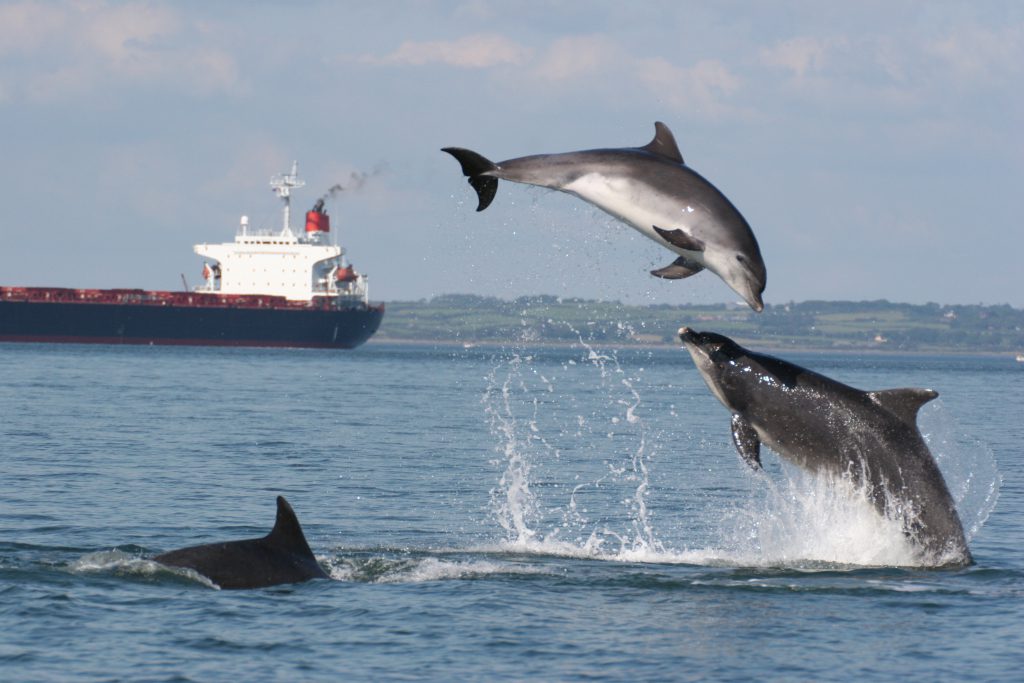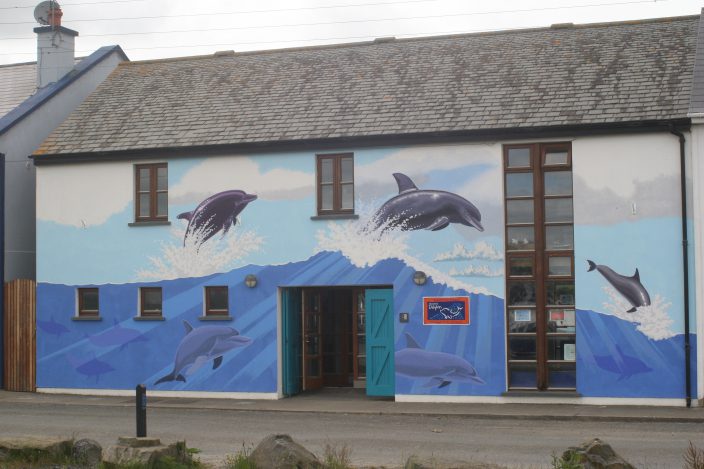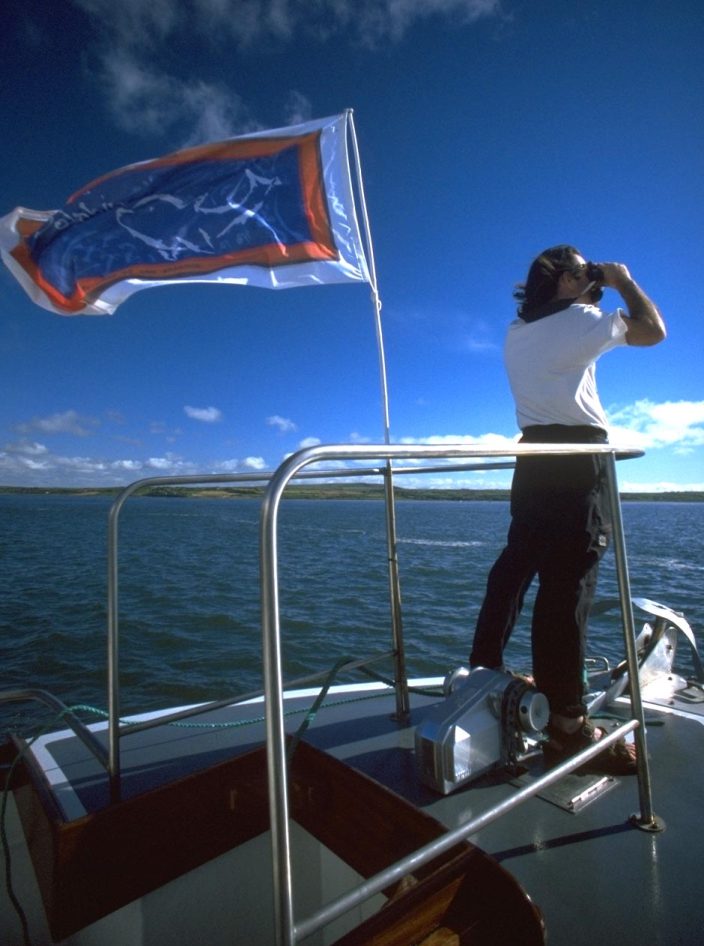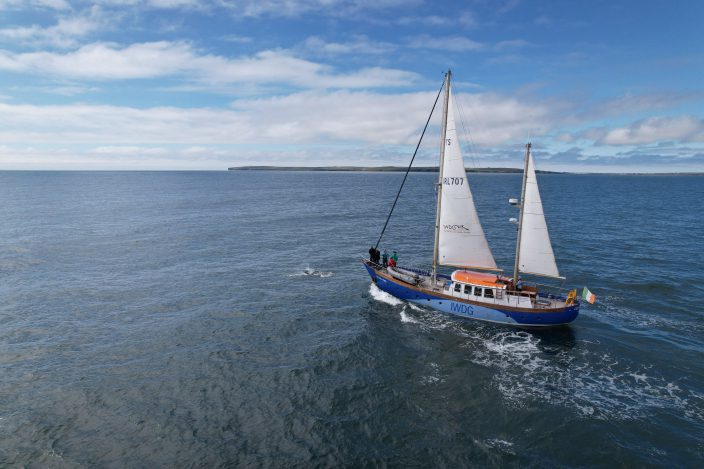After 2000, and the designation of the Shannon Estuary as a Special Area of Conservation for bottlenose dolphins, the Shannon Dolphin Project settled down. Dolphin-watching had become well established with the launch of two purpose-built dolphin-watching boats. Following the SAC designation, the National Parks and Wildlife Service (NPWS) based a Conservation Ranger in west Clare and an office was provided in the Scattery Island Visitor Centre on Merchants Quay, near Kilrush Marina. With support from the then Minister for Heritage, Síle de Valera, an office was also provided for me as manager of the Shannon Dolphin Project. At this stage we had formed the Shannon Dolphin and Wildlife Foundation (SDWF), a registered charity which aimed to bring together stakeholders in the estuary interested in the dolphins, with representatives from the NPWS and two local authorities, both dolphin-watching companies and local community groups. John Quinlivan from Shannon Development chaired the SDWF and the newly formed organisation had great success, not in a small part due to the support of Síle de Valera TD who requested that both the NPWS and National Monuments, who owned the Scattery Island Visitor Centre in Kilrush, support our work.
Due to the SAC status, dolphin-watching was a “Notifiable Action” as it was an activity which could potentially disturb the dolphins which the NPWS were seeking to protect. This led to the development of tour-boat monitoring protocols, including opportunities to collect photo-id images of the dolphins from tour boats. The NPWS supported a research assistant at the SDWF each summer to carry out this monitoring. Dolphin-watching companies were required to document each trip including where dolphins were watched, how many were present including the presence of calves. As part of the Code of Conduct, which was prepared by the tour boat skippers and endorsed by the NPWS, dolphin-watching was limited to a maximum of 30 minutes per group per trip[1]. The tour-boats provided a platform for photo-id and the SDWF accompanied a minimum of 20 trips per season from each of the two main ports of Carrigaholt and Kilrush in west Clare. In some years dolphin-watching was also carried out from Kilbaha near Loop Head and from Doon on the Kerry side of the estuary, but the two main companies of Dolphinwatch Carriagaholt and Discover Dolphins in Kilrush accounted for 98% of all trips. With this structure in place and confident that we had a mechanism to monitor the dolphins and the potential impact of dolphin-watching, we launched an eco-label called Saoirse na Sionna (Freedom of the Shannon) which endorsed dolphin-watching vessels who adopted the Code of Conduct and supported monitoring, education and research. Saoirse na Sionna was an attempt to promote best practice through marketing and encouraging those wishing to go dolphin-watching to only support those vessels operating under the Saoirse na Sionna scheme.
As well as this long-term dolphin watching monitoring there were specific research projects and SAC monitoring opportunities in the Shannon Estuary. Every 3 to 4 years the NPWS funded surveys to monitor dolphin population abundance and status. This involved deriving abundance estimates using mark-recapture modelling of photo-id data, which was required for the NPWS to report to Europe on the conservation status of the dolphins. These contracts were put out to tender and the SDWF competed with UCC to win this work. Abundance estimates were carried out in 2003, 2006, 2008, 2010, 2015, 2018 and most recently in 2022, which shows that the population is stable, within the ability of the technique to measure change.
In 2004 the SDWF was awarded its first big research project when Vodafone supported the innovative Soundwaves project. The ambition was to deploy a hydrophone in the estuary and stream a live signal through the Vodafone network to our dolphin centre in Kilrush. The project was challenging but with the expertise of Brian Holmes at UCC, we finally managed to acquire a signal from Kilcredaun near Carrigaholt and after double-compressing the file, sent it through the Vodafone network to our research centre in Kilrush. Our work featured on RTE Nationwide, but the network proved to slow, especially upload speed, to stream a signal in real time.
An exciting project the SDWF were involved in with Bord Iascaigh Mhara (BIM), was to test the efficacy of new acoustic deterrents on dolphins which were designed to deter dolphins from being caught in pelagic trawl nets. These Acoustic Deterrent Trials carried out in the summer of 2005, involved controlled exposure trials whereby dolphins were presented with two different types of deterrents to monitor any behavioural changes. SDWF researchers recorded dolphin behaviour through “blind trials”, in that they were unaware of which deterrent was being used or whether they were on or off. The trials were very successful with most dolphins showing evasive behaviour when deterrents were active[2]. However not all dolphins behaved this way, and we wondered if those dolphins which ignored the alerts, were the ones likely to be caught in fishing nets.
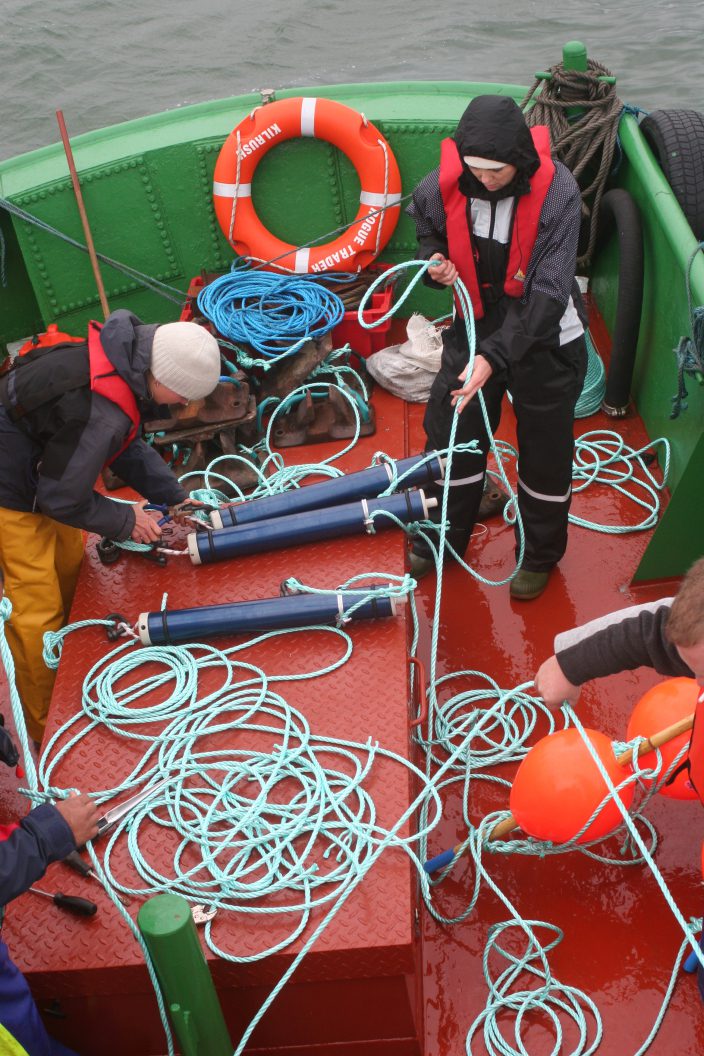
Preparing TPODs for deployment in the Shannon Estuary during BIM sponsored acoustic Deterrent Trials in 2005.
In 2001 we deployed a POD to monitor dolphin occurrence at at Foynes which was the site of the proposed crossing of the estuary of the Gas Pipeline to the West. This pipe was to connect Cork with the new gas terminal in Broadhaven Bay in north Mayo and to Scotland and Europe. PODs are automated detectors which log the echolocation clicks of dolphins and porpoises and manufactured by a colleague in the UK. Originally designed to explore porpoise behaviour around gillnets, they could also be used to assess habitat use by dolphins. PODs are now in their fourth design iteration (FPODs) and widely used throughout the world, but this was the first deployment of a POD in Ireland. Monitoring showed dolphins were only occasionally passing the proposed site and it was not an important feeding area or habitat and the pipeline was laid with appropriate rock armour in 2003. Since 2001 we have deployed TPODS, CPODs and now FPODS at 15 different sites with over 2000 days of accumulated acoustic data. This work was mainly carried out by Joanne O’Brien who is now one of Ireland’s leading cetacean acoustic experts. This static acoustic monitoring has given us wonderful insights into how dolphins use the estuary, especially in the inner estuary[3] and is an essential tool for long-term monitoring and impact assessment.
We had long been aware of bottlenose dolphins using Tralee and Brandon Bays to the west of the Shannon Estuary. In 2012 the North Kerry LEADER group through John Moriarty, approached the IWDG to carry out surveys and training to support the development of marine tourism in the area. IWDG had been donated Celtic Mist in 2011 from the Haughey family and now, after extensive refit in Kilrush, was ready for work. Over the summer 2013 we surveyed Brandon and Tralee Bays from Celtic Mist and recorded 70 individual dolphins which were all part of the Shannon population[4]. We suspect the Shannon dolphins are using Brandon Bay more than in previous years with some individual dolphins not being recorded back in the Shannon since being observed in Brandon ! This has important implications for estimating survival[5] and we have been trying to survey Brandon and Tralee each year as part of our long-term monitoring.
The Shannon Dolphin Project has supported a large number of PhD and MSc students to carry out their research. The intern programme, where students from all over the world have volunteered some of their time to our long-term monitoring, has been a great success and is the only way we could have continued collecting photo-id data, sorting, matching and analysing images over the 30 years. This hard grind is the basis of all the fantastic dolphin stories being shared by our Shannon Dolphin Project Officer, Mags Daly.
The Shannon Dolphin Project is one of the longest running dolphin monitoring projects in Ireland, which to survive so long, is in itself, a success. Through this hard work we are in a good position to inform and influence managers and decision-makers, represent the dolphins, and their habitats, in risk assessments and strategic plans. Pressure is building on the estuary which is seen as a huge economic driver for the west. The ESB have announced the Green Atlantic Hub as the future for Moneypoint Power Station, New Fortress Energy are hoping to build a Shannon Technology and Energy Park, including an LNG terminal at Ardmore Point in North Kerry, Shannon Foynes, the largest stakeholder in the estuary, is planning to expand their port at Foynes and provide new facilities elsewhere in the estuary. How can we use our knowledge and experience to effectively protect the dolphins for the next 30 years ? We will explore this in the next Shannon Dolphin Story article.
Simon Berrow
Research assistants
Sarah Ferriss (June – September 2000); Lisa Groth (June – November 2001); Shelia Downes (Sept – November 2002); Joanne O’Brien (2003 – 2004); Andrew Young (June – August 2005); Conor Ryan (August 2005); Randal Counihan (June – Sept 2005); Janelle Atkinson (Nov 2005 -Dec 2006); Randall Counihan (June – Sept 2007); Conor Ryan (June – September 2008); Conor Ryan (June – September 2009); Aoife Foley (June – September 2010); Paddy O’Dwyer (June 2011); Sarah Blennerhassett (July 2011); Enda McKeogh (June – September 2011); Isabel Baker (June – September 2012); Isabel Baker (June – October 2013); Clowie Russell (June – September 2013); Rebecca Tracey (June – September 2013); Mick Marrinan (June – August 2013); Stephanie Levesque (July – Sept 2013); Chantelle Barry (July – August 2013); Stefanie Rowland (August – Sept 2013); Katharina Reusch (June – Sept 2014); Mark Hosford (June – September 2014); Victoria Odynsky (June – Sept 2014); Gary Robinson (June – September 2014); Stephanie Levesque (June – Sept 2016); Katharina Reusch (May – Sept 2015); Meadhbh Quinn (May – Sept 2016); Jamie Nicol (May – September 2015); Andrew Shine (May – September 2015); Elisa Keeling-Hemphill (May – June 2015); Joel Vikberg Wernstrom (June – August 2015); Jamie Philips (2016); Stephanie Linehan (2016); Emer Keavney (2016); Mags Daly (May 2017 – Present); Claire Kelly (May – August 2017); Claudia Pich (June-August 2017); Sean O’Callaghan ( June – August 2018); Chris Sharples (June – August 2018); Luana Jungmann (May – August 2019); Karen Van Dorp (June – August 2019); 2020 – No interns due to Covid; 2021 – No interns due to Covid; Megan Clarkson (May – Sept 2022); Megan Keville (June – August 2022); Mateja Svonja (May – July 2022); Noel Langan (May – August 2022); Kirsten Wohak (August 2022); Luisa Lopez Munoz (June – August 2023); Lina Ireland (June – August 2023); Samy Zagara (June – August 2023)
[1] This Code of Conduct formed the basis of Marine Notice 15 of 2005 “Guidelines For Correct Procedures When Encountering Whales And Dolphins In Irish Coastal Waters”
[2] Leeney, R., Berrow, S.D., McGrath, D., O’Brien, J., Cosgrove, R. and Godley, B.J. (2007) Effects of pingers on the behaviour of bottlenose dolphins. Journal of the Marine Biological Association (UK) 87, 129-133.
[3] Carmen, M., Berrow, S.D., O’Brien, J.M. (2021) Foraging Behavior of Bottlenose Dolphins in the Shannon Estuary, Ireland as Determined through Static Acoustic Monitoring. J. Mar. Sci. Eng. 2021, 9, 275. https:// doi.org/10.3390/jmse9030275
[4] Levesque, S., Reusch, K., Baker, I., O’Brien, J. and Berrow, S. (2016) Photo-Identification of Bottlenose Dolphins (Tursiops truncatus) in Tralee Bay and Brandon Bay, Co. Kerry: A Case for SAC Boundary Extension. Biology and Environment: Proceedings of the Royal Irish Academy 2016. DOI: http://dx.doi.org/ 10.3318/BIOE.2016. 11
[5] Ludwig, K.E., Daly, M., Levesque, S. and Berrow, S.D. (2021) Survival Rates and Capture Heterogeneity of Bottlenose Dolphins (Tursiops truncatus) in the Shannon Estuary, Ireland. Front. Mar. Sci. 8:611219. doi: 10.3389/fmars.2021.611219

